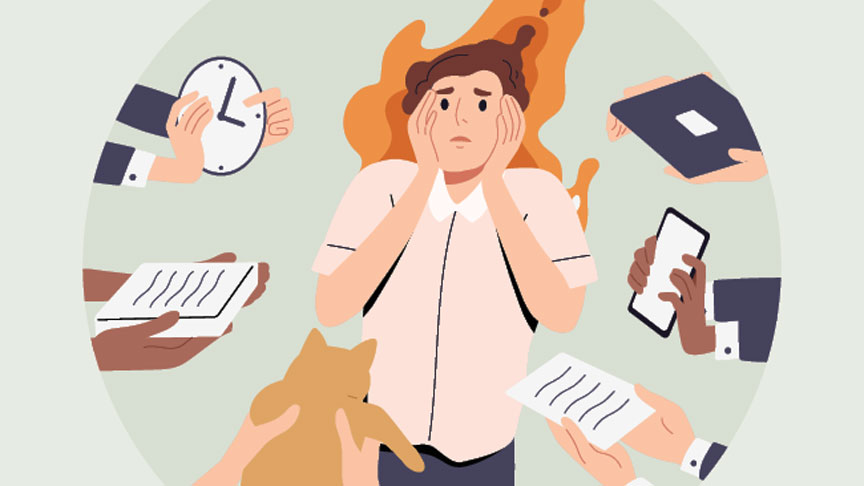Burnout is the main reason why women have or are preparing to quit their jobs, per recent data from 360Learning. In fact, compared to 21% of males, 25% of women have left or are considering leaving their current occupations due to burnout. The poll also reveals that 18% of women have left their jobs because they don't feel fulfilled at work.
In addition to the poll conducted by 360Learning, a recent analysis by McKinsey on women in the workplace found that 42% of women feel burnout, compared to 35% of males. Another poll conducted by LinkedIn confirms this pattern, with 74% of women reporting stress at work compared to 61% of males.
These figures demonstrate that one of the main causes of the Great Resignation was burnout. To assist combat burnout, organizations must take action. What is burnout, and why do women suffer from it more than men? For tips on how to assist and mentor women in the workplace more effectively, keep reading.
Describe burnout

According to WHO, burnout is a syndrome that was developed as a result of ongoing working stress that a company has failed to effectively manage. The following traits describe burnout:
- A sensation of being worn out or low in energy
- Decreased professionalism
- More separation from one's job in the mind
- Cynicism or disdain for one's profession
Burnout may be defined as a state of physical and emotional tiredness. Burnout may happen when a person is under a lot of stress at work or spends a long time in a physically and emotionally taxing position.
Common burnout indicators
The most typical signs of burnout include:
- Constricted, powerless, and defeated
- Being generally exhausted or drained
- Having a pessimistic or cynical viewpoint
- Feeling alone or cut off from reality
- Self-doubt
- Feeling overwhelmed
- Putting off and taking longer to do easy tasks
Why is burnout a major issue?
Burnout is a condition that does not go away by itself. If you don't treat the underlying problems causing it, it can even grow worse. Employers risk greater injury to their employees' emotional and physical health if they overlook burnout warning signs. Employees are more likely to lose the motivation and capacity to carry out their duties successfully as a result, which is harmful to the organization as a whole.
Are women in leadership roles more prone to burnout?

In comparison to males in comparable roles, women in leadership had higher rates of chronic stress, tiredness, and burnout, according to a McKinsey analysis. According to the study, women in senior leadership positions are more likely than males to work from home and do more tasks outside of their formal responsibilities and normal working hours.
In fact, burnout affects women in leadership positions the most, with at least 50% reporting that they are suffering from it at work. Only in 2020, one-fourth of women in high leadership roles declared that they were prepared to downshift their careers or quit their jobs. One in three senior-level women are now trying to leave their jobs or unload important responsibilities.
Burnout among women has two main causes
All genders and nations experience burnout, although women are disproportionately impacted. These are a few of the causes of women being more prone to burnout:
#1. The likelihood of women having unpaid labor duties is higher
Burnout is being brought on by the demands of caregiving, and many women are ceasing to work completely or leaving full-time jobs. Many women are in charge of the majority of the unpaid work in their homes in addition to their full-time jobs. According to other study, women work four times as many hours in the home unpaid as men do.
Women are also assuming extra responsibilities outside of their professional jobs, such as supporting DEI groups and committees, assisting team members who are burnt out, or assisting them in juggling work and personal obligations.
#2. The rung that snapped
In the first step up to manager, there is still a "broken rung," according to McKinsey's 2021 Women in the Workplace study. The tendency, which has persisted since 2016, is that women are promoted to managerial positions at far lower rates than males, which makes it difficult for businesses to build a foundation for long-term advancement at higher levels. In actuality, only 72 women are promoted to manager for every 100 males that are employed. In addition, men hold 62% of management jobs, compared to 36% for women.
Women are more likely to experience burnout because of all of these variables, including taking on unpaid caregiving duties and extra work outside of their professional employment and the fact that they are still promoted to managers at far lower rates than males.
What can organizations do, then, to stop female burnout? And what can they do to help women more effectively at work?
There are four things businesses may take to combat burnout

Both companies and employees are quite concerned about burnout. However, L&D teams and HR executives may assist by offering assistance in managing burnout and concentrating on growth prospects. Here are some important steps businesses can take to help working women.
#1. Give the appropriate tools
According to a poll by 360Learning, 75% of women in leadership roles who left their jobs due to burnout felt their employers didn't give enough management support and training. In order to minimize burnout, this shows that organizations need to step up their game when it comes to support and training.
The aspect of work that offers your staff the energy and enthusiasm to promote learning, growth, and development is the appropriate instruments. You may start by organizing management training so that managers are equipped to recognize burnout and respond appropriately before it worsens.
Make sure you create a workplace where every employee feels protected psychologically. In an atmosphere that puts pressure on them, overlooks their interpersonal and personal problems, or penalizes errors, very few people will succeed. It is crucial to create a work atmosphere that encourages a laid-back attitude toward tasks, experimentation, forgiving of errors, and awareness of personal matters.
#2. Provide flexibility
According to the 360Learning research, 62% of the 50% of women who stated it was difficult for them to balance work and family obligations agreed that more flexible working hours would assist them, and 45% said they would welcome more flexibility with work-from-home regulations. Offer these flexible scheduling alternatives to encourage and keep women in the workforce.
#3. Promote internal movement
A further strategy to avoid burnout is to make sure that all of your staff have prospects for advancement. To accomplish this, for example:
- Actively seek internal career possibilities for your staff
- Determine the ideal fit between a job and a person
- Assist workers in developing their ability for what matters to them
- Pay more attention to staff members who voluntarily handle feedback
#4. Express your commitment to assisting others in developing
Enjoying your work is a wonderful feeling. Unfortunately, the poll conducted by 360Learning revealed that some women are dissatisfied with or bored with their jobs, or they are angry about their chances to progress and learn. Because of this, it's critical to acknowledge and value women in the workforce.
To begin with, inquire about the feelings of your staff members. Then, in order to provide them occupations that are more rewarding, you can rearrange certain chores or give people other positions. Burnout is less likely to occur when people feel valued and are able to use their abilities to the fullest extent. So, ensure that everyone has an equal chance to develop professionally. Above all, remember to express your gratitude to a worker for a job well done.
The verdict on burnout at work
It is crucial for you to check on your employees' burnout as an employer. Employers must take burnout seriously since it may cost damages to their business.
Source: hrnews.co.uk








